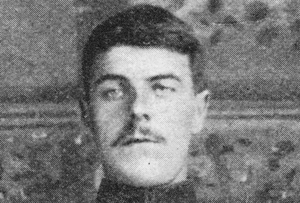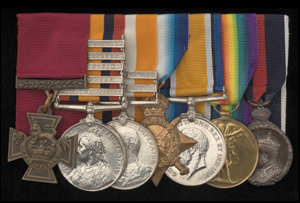Horace Henry Glasock VC
Name: Horace Henry Glasock
Conflict: Second Boer War
Gazetted: June 26, 1900
Service: Army

Horace Henry Glasock VC

Medal group
Place/date of birth: Islington, London/October 16, 1880
Rank when awarded VC (and later highest rank): Driver
Date of bravery: March 31, 1900
London Gazette citation [joint citation]:
On the occasion of the action at Korn Spruit on the 31st March, 1900, a British force, including two batteries of the Royal Horse Artillery, was retiring from Thabanchu towards Bloemfontein. The enemy had formed an ambush at Korn Spruit, and before their presence was discovered by the main body had captured the greater portion of the baggage column and five out of the six guns of the leading battery.
When the alarm was given Q Battery, Royal Horse Artillery, was within 300 yards of the Spruit. Major Phipps-Hornby, who commanded it, at once wheeled about and moved off at a gallop under a very heavy fire. One gun upset when a wheel horse was shot, and had to be abandoned, together with a waggon, the horses of which were killed. The remainder of the battery reached a position close to some unfinished railway buildings and came into action 1,150 yards from the Spruit, remaining in action until ordered to retire. When the order to retire was received Major Phipps-Hornby ordered the guns and their limbers to be run back by hand to where the teams of uninjured horses stood behind the unfinished buildings. The few remaining gunners, assisted by a number of Officers and men of a party of Mounted Infantry, and directed by Major Phipps-Hornby and Captain Humphreys, the only remaining Officers of the battery, succeeded in running back four of the guns under shelter. One or two of the limbers were similarly withdrawn by hand, but the work was most severe and the distance considerable. In consequence all concerned were so exhausted that they were unable to drag in the remaining limbers or the fifth gun. It now became necessary to risk the horses, and volunteers were called for from among the drivers, who readily responded. Several horses were killed and men wounded, but at length only one gun and one limber were left exposed. Four separate attempts were made to rescue these, but when no more horses were available the attempt had to be given up and the gun and limber were abandoned.
Meanwhile the other guns had been sent on, one at a time, and after passing within 700 or 800 yards of the enemy, in rounding the head of a donga and crossing two spruits they eventually reached a place of safety, where the battery was re-formed.
After full consideration of the circumstances of the case the Field-Marshal Commanding-in-Chief in South Africa formed the opinion that the conduct of all ranks of Q Battery, Royal Horse Artillery, was conspicuously gallant and daring, but that all were equally brave and devoted in their behaviour. He therefore decided to treat the case of the battery as one of collective gallantry under Rule 13 of the Victoria Cross Warrant, and directed that one Officer should be selected for the decoration of the Victoria Cross by the Officers, one non-commissioned officer by the non-commissioned officers, and two gunners or drivers by the gunners and drivers…
…Gunner Isaac Lodge and Driver Henry Glasock were elected by the gunners and drivers, as described above.
Click here to see full Gazette entry.
Other decorations: N/A
Place/date of death: Cape Town, South Africa/October 20, 1916
Grave/memorials: Maitland Crematorium, Cape Town, South Africa; Royal Artillery Chapel, Woolwich, London
Origin of VC to the Lord Ashcroft collection: Purchased at auction, Spink, London, 1998
Current location of VC: Displayed on rotation at The Lord Ashcroft Gallery: Extraordinary Heroes exhibition, Imperial War Museum